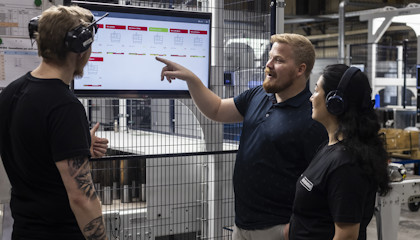5 tips to improve shop floor management

Why do most digital journeys start and then fumble, taking much longer to see results? It’s how data is handled from the beginning to the end.
Data is unescapable, collected from several shop floor machines, quality software, CAM software, machine monitor, and ERP systems can create positive returns. However, the real impact of data happens when it's analyzed, interpreted, and applied to operations to help drive decisions and improvements.
Using data enables shops to pinpoint areas of inefficiencies, improve troubleshooting, accuracy, and instill confidence in employees. Plus, data can help you reach more sustainable manufacturing. Allowing your company to build credibility as a reliable supplier and, in turn, helping to grow your business.
If you're a manufacturer just getting started, remember staff buy-in is one of the most critical factors for data utilization.

1. Be visionary
Every machine shop's vision should include transparency between all departments to help guide the company's future direction and allow data to become the red thread.
Your staff can focus on targeting inefficiencies because data collected on the shop floor is transparent and nearly indisputable.
In these first few steps, I’ll walk you through the essentials to dedicate time to all departments and to ensure everyone understands their responsibilities. By having an in-depth vision and how the company wants to operate to reach company goals you set up your shop floor and employees for success.
This critical step will help your staff see how their work connects to the bigger picture, giving them a sense of purpose and motivation.
To keep morale up and communication open, here are two tips to ensure success:
- Making tablets available on the shop floor, and
- Setting up a Microsoft Teams accounts for every employee
Genuine communication enhances transparency and encourages everyone to walk the same path toward the same goals.
2. Take a backseat
From my exchanges with several machine shops, the number one challenge for customers who strive to digitalize their shop floor is handling change management.
Typically, managers need to define strategies for change management. It's all too familiar for the people affected by the change to fall by the waist side and are not involved in the change process.
Without a doubt, operators, technicians, application engineers, and quality assurance personnel need to participate in the problem-solving process, allowing all team members to understand why the changes are necessary.
 When adopting a new way of working, staff directly affected will be the defining factor if the change is successful or not. Involving individuals early is essential. Their skills can be utilized for decision-making and testing, giving employees a sense of empowerment. And when the benefits are self-evident, supported by data, this leads to less energy spent on change resistance and convincing.
When adopting a new way of working, staff directly affected will be the defining factor if the change is successful or not. Involving individuals early is essential. Their skills can be utilized for decision-making and testing, giving employees a sense of empowerment. And when the benefits are self-evident, supported by data, this leads to less energy spent on change resistance and convincing.
3. Be a broken record – It's trendy
For data to be infused in every aspect of your value chain, it will likely require increased usage of existing software solutions. This involves training all employees and dedicating time to implementing the new software.
Having this solid foundation can ease your digital transformation buy-in.
Here are some examples that can help instill healthy habits and increase transparency:
- Having a frequent internal communication plan to express the importance of a new solution being implemented.
- Appointing advocates to motivate the digital solution purpose and provide guidance to fellow colleagues on how to use the solution.
- Create steps that allow staff to review the data that triggers a part deviation to help explain the "why."
- Set up tasks for your management team to review data to track progress in fulfilling quotas to help plan orders.
There's no doubt patience is vital, but with a bit of grit, the payoff and the benefits will soon be presented, and you'll start to discover new dimensions for efficient output.

4. Discover new dimensions
How a machine shop operates will constantly shift as software and hardware are ever-changing, with updates affecting how to interact and analyze data.
More data insights may be available, or the user flow for software will be in constant flux to reach specific shop floor goals as software is continually updated. Even if digital solutions are installed and used as intended, there is always room for improvement and opportunities to optimize.
You must develop methods that drive continuous improvement and evolve with solution updates.
Despite the endless list of shortcomings and areas of improvement existing throughout the shop, continuous improvement is successfully achieved through a step-by-step approach with clear and concise goals. In other words, prioritization is led by shortlisted focus areas associated with long-term goals.
Equally crucial to defining goals is to support continuous improvement in evaluating data collection, visualization, and security measures. Many times, data is dependent on people to input information into the system, which can result in human error. Therefore, data should be cross-referenced with other systems and tested to guarantee accuracy.
Moreover, data should be easily accessible and visualized in a straightforward format to easily draw conclusions.
Another dimension is understanding all the privacy laws and customer requirements affecting shop security. Therefore, it's crucial to investigate cloud solution security capabilities and, in some cases, hire services to test the vulnerability of accessing the data collected by your shop.
5. Leverage happiness as a superpower
Democratizing data is vital to unlocking happiness on your shop floor. Why? Because happy employees become engaged regardless of their technical background. I've witnessed shop floor staff make decisions confidently based on data - ultimately increasing shop floor efficiencies.
Every machine shop's vision should include transparency between all departments to help guide the company's future direction and allow data to become the red thread.
Staff can then focus on improving inefficiencies because data collected on the shop floor is transparent and nearly indisputable. In turn, this creates a shared understanding of what is happening and highlights where to place more focus to meet shop targets.

When employees can interpret the data, draw conclusions, pinpoint issues, and solve them, you empower them through knowledge. Empowered employees are happy employees, which is how you leverage happiness as a superpower.
A digital journey begins with solutions, but it thrives with established processes and automation, continuous improvements, and a healthy, positive work environment, empowering employees to be part of the change.
Discover more day-to-day shop floor success from one of Sandvik’s Lighthouse Partners, Fårbo Mekaniska AB.